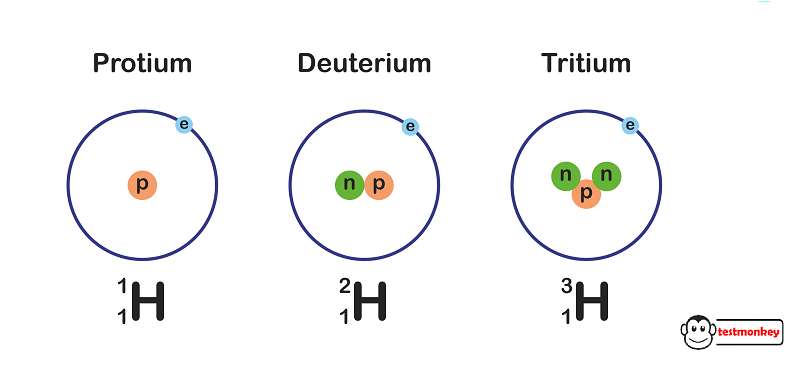Hydrogen has three isotopes: protium (1H), deuterium (2H), and tritium (3H). Protium is the most common isotope and has no neutrons, deuterium has one neutron, and tritium has two neutrons.
Details about the isotopes of hydrogen :
- Protium (1H): Protium is the most common and stable isotope of hydrogen. Its nucleus contains one proton and no neutrons. It is sometimes called “ordinary hydrogen” and accounts for more than 99.98% of naturally occurring hydrogen on Earth.
- Deuterium (2H): Deuterium is an isotope of hydrogen that is also stable but less abundant than protium. Its nucleus consists of one proton and one neutron, making it twice as massive as protium. Deuterium is often used in nuclear research, as a tracer in chemical reactions, and in some industrial applications.
- Tritium (3H): Tritium is a radioactive isotope of hydrogen. Its nucleus contains one proton and two neutrons, making it much heavier than both protium and deuterium. Due to its radioactive nature, tritium undergoes beta decay with a half-life of approximately 12.3 years. It is used in some special applications such as self-luminous exit signs and in some types of nuclear weapons.
These isotopes of hydrogen play an important role in various scientific and industrial fields due to their unique properties.

Some applications of different isotopes of hydrogen:
Protium (1H):
Protium is the most common form of hydrogen and is used in various chemical reactions and industrial processes. It is an important component in the production of ammonia, which is used in fertilizers and other chemical products.
Protium is also used in hydrogen fuel cells to generate electricity in a clean and environmentally friendly way.
Deuterium (2H):
Deuterium is used in scientific research and as a tracer in various industrial processes. By incorporating deuterium into molecules, scientists can track chemical reactions and study the behavior of molecules in different environments.
Heavy water, which contains deuterium oxide (D2O), is used as a neutron moderator in some types of nuclear reactors. This helps to slow down neutrons to maintain a controlled nuclear reaction.
Tritium (3H):
Tritium is used in the production of self-luminous exit signs and various types of luminous paint. In nuclear research, tritium can be used as a radioactive tracer to study biochemical and physiological processes.
Tritium can be used in nuclear weapons as part of the fusion process, although its use is strictly controlled and heavily regulated.
Overall, the different isotopes of hydrogen have diverse applications in scientific research, energy production, and various industrial processes. While protium and deuterium are stable and non-radioactive, tritium’s radioactive nature makes its applications more specialized and requires careful handling and regulation.

About the Author
Manish love to write and he is a Civil Servant. Users can follow Manish on Instagram 
गर्मी के मौसम में ब्लड प्रेशर क्यों कम हो जाता है ?
गर्मियों में हमें बहुत पसीना आता है, जिससे शरीर में पानी की कमी हो जाती…
क्या होता है शीतकालीन संक्रांति [Winter solstice]
21 या 22 दिसंबर को उत्तरी गोलार्ध में शीतकालीन संक्रांति (Winter solstice) होती है। उत्तरी…
मिसाइल प्रौद्योगिकी नियंत्रण व्यवस्था (MTCR) [UPSC GS]
मिसाइल प्रौद्योगिकी नियंत्रण व्यवस्था (एमटीसीआर) MTCR 35 सदस्य देशों के बीच एक अनौपचारिक राजनीतिक समझ…
संविधान की 6वीं अनुसूची क्या है [6th schedule]
संविधान का 6वीं अनुसूची (6th schedule) असम, मेघालय, मिजोरम और त्रिपुरा के आदिवासी क्षेत्रों के…
ऑपरेशन विजय,1999 (Operation Vijay) [UPSC GS]
ऑपरेशन विजय (Operation Vijay) विजय दिवस के रूप में भारतीय सेना और वायु सेना द्वारा…
काजिन सारा (Kajin Sara Lake) झील की खोज क्यों महत्वपूर्ण है ?
नेपाल में मनांग जिले में एक नई झील मिली है। मीडिया रिपोर्टों में, इस काजीन…





![मिसाइल प्रौद्योगिकी नियंत्रण व्यवस्था (MTCR) [UPSC GS]](https://bugnews.in/wp-content/uploads/2022/03/missilesystem.jpg)


